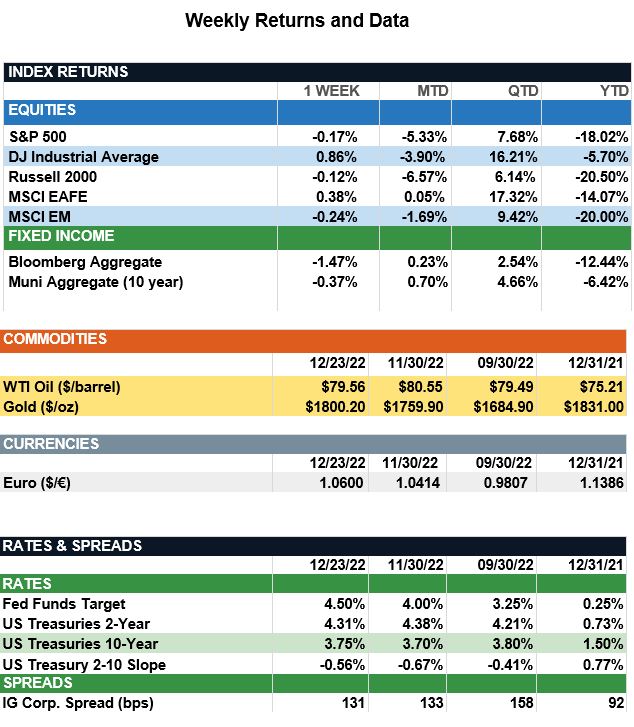Market Recap – Week ending Dec. 23
Holiday Cheer Battles Against High Inflation
Overview: Stocks around the world were largely unchanged last week in quiet trade as the year 2022 winds down. In the U.S., the S&P 500 index was down 0.2% for the week as investors continue to monitor inflation and the economy. On the inflation front, the Personal Consumption Expenditures (PCE) Price Index rose at an annual rate of 5.5% in November, down from a 6.1% reading in October. Excluding food and energy prices, prices rose at a 4.7% annual rate versus 5.0% in October. The PCE Price Index is the Federal Reserve’s preferred gauge for tracking inflation and the report shows a further cooling of prices, offering investors hope the Fed will slow the pace of rate hikes as we look forward to 2023. In bonds, yields rose and prices of Treasury bonds fell after Japan’s central bank on Monday expanded its acceptable target range for yields of Japan 10-year bonds. In the U.S., the yield of the 10-year U.S. Treasury bond climbed to 3.75% by the end of the week, up from 3.48% a week earlier. The final week of 2022 will be a light one in terms of economic reports, highlighted by a report on home prices on Tuesday, pending home sales on Wednesday, and weekly unemployment claims data on Thursday. In the first week of 2023, focus will be on the government’s monthly employment report due out on Friday, Jan. 6.
The Holiday Season (from JP Morgan): The story for the U.S. economy this year has largely been about battling record-high inflation, which has left both equity and fixed income markets bumpier than a ride on Santa’s sleigh. While we do expect a steady deceleration in inflation next year, the rate of inflation is still elevated relative to history, even after coming in below expectations for the second consecutive month in November. The bottom line is shoppers will pay the price this holiday season … in the form of costlier gifts. PNC’s Christmas Price Index, which closely mirrors U.S. CPI, has risen 10.5% from 2021 and 16.8% from pre-pandemic levels. PNC conducts an analysis to calculate the current cost for one set of each of the gifts of “true love" in the song "The Twelve Days of Christmas." Higher commodity prices have been a key driver of higher inflation this year. With livestock producers facing higher feed costs, prices for a turtle dove or a French hen rose 33.3% and 25% y/y, respectively. Similarly, higher precious metal prices boosted the cost of a gold ring by 40% y/y, representing the largest increase in the index. Settling for a calling bird or a swan-a-swimming may be a jollier option, as these goods managed to maintain their 2021 price tags.
Despite the Fed’s efforts to tame inflationary pressures, average hourly earnings, which increased 5.1% y/y in November, still remain strong due to a too-tight labor market. As a result, ladies dancing, pipers piping and drummers drumming all received a pay raise, which is unfortunate news for consumers looking to ring in the new year with some holiday entertainment. All in all, while spreading cheer may cost 9.8% more than it did in 2021, revelers may get some relief from an inflation cold front as we head deeper into the winter season.

Sources: JP Morgan Asset Management, Goldman Sachs Asset Management, Barron’s , Bloomberg
This communication is for informational purposes only. It is not intended as investment advice or an offer or solicitation for the purchase or sale of any financial instrument.
Indices are unmanaged, represent past performance, do not incur fees or expenses, and cannot be invested into directly. Past performance is no guarantee of future results.